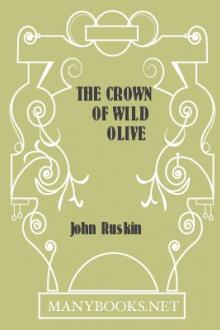The Crown of Wild Olive, John Ruskin [best ereader for graphic novels .txt] 📗

- Author: John Ruskin
- Performer: -
Book online «The Crown of Wild Olive, John Ruskin [best ereader for graphic novels .txt] 📗». Author John Ruskin
It does not matter how small or apparently symmetrical the cluster may be, nor how large or vague. You can hardly have a more formal one than b in Fig. 9. p. 276., nor a less formal one than this shoot of Spanish chestnut, shedding its leaves, Fig. 24.; but in either of them, even the general reader, unpractised in any of the previously recommended exercises, must see that there are wandering lines mixed with the radiating ones, and radiating lines with the wild ones: and if he takes the pen and tries to copy either of these examples, he will find that neither play of hand to left nor to right, neither a free touch nor a firm touch, nor any learnable or describable touch whatsoever, will enable him to produce, currently, a resemblance of it; but that he must either draw it slowly, or give it up. And (which makes the matter worse still) though gathering the bough, and putting it close to you, or seeing a piece of near foliage against the sky, you may draw the entire outline of the leaves, yet if the spray has light upon it, and is ever so little a way off, you will miss, as we have seen, a point of a leaf here, and an edge there; some of the surfaces will be confused by glitter, and some spotted with shade; and if you look carefully through this confusion for the edges or dark stems which you really can see, and put only those down, the result will be neither like Fig. 9. nor Fig. 24., but such an interrupted and puzzling piece of work as Fig. 25.[228]
Now, it is in the perfect acknowledgment and expression of these three laws that all good drawing of landscape consists. There is, first, the organic unity; the law, whether of radiation, or parallelism, or concurrent action, which rules the masses of herbs and trees, of rocks, and clouds, and waves; secondly, the individual liberty of the members subjected to these laws of unity; and, lastly, the mystery under which the separate character of each is more or less concealed.
I say, first, there must be observance of the ruling organic law. This is the first distinction between good artists and bad artists. Your common sketcher or bad painter puts his leaves on the trees as if they were moss tied to sticks; he cannot see the lines of action or growth; he scatters the shapeless clouds over his sky, not perceiving the sweeps of associated curves which the real clouds are following as they fly; and he breaks his mountain side into rugged fragments, wholly unconscious of the lines of force with which the real rocks have risen, or of the lines of couch in which they repose. On the contrary, it is the main delight of the great draughtsman to trace these laws of government; and his tendency to error is always in the exaggeration of their authority rather than in its denial.
Secondly, I say, we have to show the individual character and liberty of the separate leaves, clouds, or rocks. And herein the great masters separate themselves finally from the inferior ones; for if the men of inferior genius ever express law at all, it is by the sacrifice of individuality. Thus, Salvator Rosa has great perception of the sweep of foliage and rolling of clouds, but never draws a single leaflet or mist wreath accurately. Similarly, Gainsborough, in his landscape, has great feeling for masses of form and harmony of colour; but in the detail gives nothing but meaningless touches; not even so much as the species of tree, much less the variety of its leafage, being ever discernable. Now, although both these expressions of government and individuality are essential to masterly work, the individuality is the more essential, and the more difficult of attainment; and, therefore, that attainment separates the great masters finally from the inferior ones. It is the more essential, because, in these matters of beautiful arrangement in visible things, the same rules hold that hold in moral things. It is a lamentable and unnatural thing to see a number of men subject to no government, actuated by no ruling principle, and associated by no common affection: but it would be a more lamentable thing still, were it possible to see a number of men so oppressed into assimilation as to have no more any individual hope or character, no differences in aim, no dissimilarities of passion, no irregularities of judgment; a society in which no man could help another, since none would be feebler than himself; no man admire another, since none would be stronger than himself; no man be grateful to another, since by none he could be relieved; no man reverence another, since by none he could be instructed; a society in which every soul would be as the syllable of a stammerer instead of the word of a speaker, in which every man would walk as in a frightful dream, seeing spectres of himself, in everlasting multiplication, gliding helplessly around him in a speechless darkness. Therefore it is that perpetual difference, play, and change in groups of form are more essential to them even than their being subdued by some great gathering law: the law is needful to them for their perfection and their power, but the difference is needful to them for their life.
And here it may be noted in passing, that if you enjoy the pursuit of analogies and types, and have any ingenuity of judgment in discerning them, you may always accurately ascertain what are the noble characters in a piece of painting, by merely considering what are the noble characters of man in his association with his fellows. What grace of manner and refinement of habit are in society, grace of line and refinement of form are in the association of visible objects. What advantage or harm there may be in sharpness, ruggedness, or quaintness in the dealings or conversations of men; precisely that relative degree of advantage or harm there is in them as elements of pictorial composition. What power is in liberty or relaxation to strengthen or relieve human souls; that power, precisely in the same relative degree, play and laxity of line have to strengthen or refresh the expression of a picture. And what goodness or greatness we can conceive to arise in companies of men, from chastity of thought, regularity of life, simplicity of custom, and balance of authority; precisely that kind of goodness and greatness may be given to a picture by the purity of its colour, the severity of its forms, and the symmetry of its masses.
You need not be in the least afraid of pushing these analogies too far. They cannot be pushed too far; they are so precise and complete, that the farther you pursue them, the clearer, the more certain, the more useful you will find them. They will not fail you in one particular, or in any direction of enquiry. There is no moral vice, no moral virtue, which has not its precise prototype in the art of painting; so that you may at your will illustrate the moral habit by the art, or the art by the moral habit. Affection and discord, fretfulness and quietness, feebleness and firmness, luxury and purity, pride and modesty, and all other such habits, and every conceivable modification and mingling of them, may be illustrated, with mathematical exactness, by conditions of line and colour; and not merely these definable vices and virtues, but also every conceivable shade of human character and passion, from the righteous or unrighteous majesty of the king, to the innocent or faultful simplicity of the shepherd boy.
The pursuit of this subject belongs properly, however, to the investigation of the higher branches of composition, matters which it would be quite useless to treat of in this book; and I only allude to them here, in order that you may understand how the utmost nobleness of art are concerned in this minute work, to which I have set you in your beginning of it. For it is only by the closest attention, and the most noble execution, that it is possible to express these varieties of individual character, on which all excellence of portraiture depends, whether of masses of mankind, or of groups of leaves.
Now you will be able to understand, among other matters, wherein consists the excellence, and wherein the shortcoming, of the tree-drawing of Harding. It is excellent in so far as it fondly observes, with more truth than any other work of the kind, the great laws of growth and action in trees: it fails—and observe, not in a minor, but in a principal point—because it cannot rightly render any one individual detail or incident of foliage. And in this it fails, not from mere carelessness or incompletion, but of necessity; the true drawing of detail being for evermore impossible to a hand which has contracted a habit of execution. The noble draughtsman draws a leaf, and stops, and says calmly—That leaf is of such and such a character; I will give him a friend who will entirely suit him: then he considers what his friend ought to be, and having determined, he draws his friend. This process may be as quick as lightning when the master is great—one of the sons of the giants; or it may be slow and timid: but the process is always gone through, no touch or form is ever added to another by a good painter without a mental determination and affirmation. But when the hand has got into a habit, leaf No. 1. necessitates leaf No. 2.; you cannot stop, your hand is as a horse with the bit in its teeth; or rather is, for the time, a machine, throwing out leaves to order and pattern, all alike. You must stop that hand of yours, however painfully; make it understand that it is not to have its own way any more, that it shall never more slip from, one touch to another without orders; otherwise it is not you who are the master, but your fingers. You may therefore study Harding's drawing, and take pleasure in it;[229] and you may properly admire the dexterity which applies the habit of the hand so well, and produces results on the whole so satisfactory: but you must never copy it, otherwise your progress will be at once arrested. The utmost you can ever hope to do, would be a sketch in Harding's manner, but of far inferior dexterity; for he has given his life's toil to gain his dexterity, and you, I suppose, have other things to work at besides drawing. You would also incapacitate yourself from ever understanding what truly great work was, or what Nature was; but by the earnest and complete study of facts, you will gradually come to understand the one and love the other more and more, whether you can draw well yourself or not.
I have yet to say a few words respecting the third law above stated, that of mystery; the law, namely, that nothing





Comments (0)